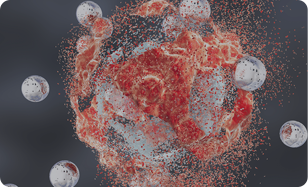Microalgae Analysis: Methods, Applications, and Insights for Researchers
Microalgae are a diverse group of microscopic organisms that can perform photosynthesis and are found in both freshwater and marine environments. They play a crucial role in ecological balance, nutrient cycling, and carbon fixation. Additionally, due to their high lipid content, bioactive compounds, and potential for large-scale cultivation, microalgae are gaining significant interest for applications in biofuels, pharmaceuticals, and environmental management. In this article, we explore the different methods for microalgae analysis, including their isolation, purification, and analysis techniques, and discuss their importance for researchers looking to unlock the full potential of these remarkable organisms.
What is Microalgae?
Microalgae are unicellular or colonial photosynthetic organisms that are typically less than 50 micrometers in size. They are found in diverse habitats, ranging from freshwater lakes to the open ocean. Microalgae are crucial primary producers in aquatic ecosystems, as they convert sunlight, water, and carbon dioxide into oxygen and organic compounds. This ability to photosynthesize makes them an essential component of the food chain and a valuable resource for industries looking to harness their biological properties.
Microalgae can be classified into several groups, including:
l Green algae (Chlorophyta): Found in both freshwater and marine environments, green algae are rich in proteins and lipids.
l Diatoms (Bacillariophyta): These algae are known for their unique silica-based cell walls and are important in carbon sequestration.
l Cyanobacteria: Also known as blue-green algae, these organisms are often used for biofuel production and nitrogen fixation.
l Red algae (Rhodophyta): Rich in antioxidants and other bioactive compounds, red algae have numerous pharmaceutical and nutritional applications.
Microalgae Analysis Methods
Microalgae analysis involves various methods that help researchers examine the growth, composition, and metabolic pathways of these organisms. These methods can be broadly divided into physiological, biochemical, and molecular techniques.
1. Physiological Analysis
Physiological analysis is essential for understanding the metabolic and growth characteristics of microalgae. Common techniques include:
l Cell Counting and Growth Monitoring: Researchers can monitor microalgae growth through direct microscopic observation or automated methods like flow cytometry and hemocytometers. Spectrophotometers are often used to measure optical density, giving an estimate of biomass based on light absorption by the algal culture.
l Chlorophyll Fluorescence: This technique measures the efficiency of photosystem II in microalgae. Fluorescence measurements provide insights into the algal stress responses, photosynthetic activity, and overall health. Chlorophyll fluorescence is often used in conjunction with pulse amplitude modulation (PAM) fluorometry for assessing photosynthetic performance.
l Oxygen Evolution Measurements: By measuring oxygen evolution rates, researchers can assess the efficiency of photosynthesis and algal metabolism. These measurements help understand the energy conversion processes and the impact of different growth conditions on algal health.
2. Biochemical Analysis
Biochemical analysis focuses on the composition of microalgae, particularly the production of bioactive compounds such as lipids, proteins, and carbohydrates. This type of analysis is essential for applications in biofuels, pharmaceuticals, and food supplements.
l Lipid Quantification: Lipid content, particularly triglycerides, is an important metric in biofuel research. Techniques like gas chromatography (GC) and high-performance liquid chromatography (HPLC) are frequently used to analyze lipid profiles in microalgal species.
l Protein and Carbohydrate Analysis: Proteins and carbohydrates in microalgae are valuable for nutritional purposes. Standard biochemical assays, such as the Bradford assay for proteins or phenol-sulfuric acid method for carbohydrates, help quantify these components.
l Pigment Analysis: Microalgae are rich in pigments such as chlorophyll, carotenoids, and phycobiliproteins, which are crucial for photosynthesis. High-performance liquid chromatography (HPLC) and spectrophotometric techniques are commonly used to identify and quantify these pigments.
3. Molecular Analysis
Molecular techniques provide insights into the genetic makeup of microalgae, allowing researchers to explore their metabolic pathways, stress responses, and potential for genetic modification.
l DNA/RNA Sequencing: High-throughput sequencing technologies, such as next-generation sequencing (NGS), enable researchers to sequence the genomes and transcriptomes of microalgae. This helps identify genes involved in critical metabolic pathways like lipid biosynthesis or nitrogen assimilation.
l PCR and qPCR: Polymerase chain reaction (PCR) is used to amplify specific genes, while quantitative PCR (qPCR) measures gene expression levels. These tools allow researchers to track changes in gene expression in response to environmental factors or genetic modifications.
l Metabolomics: Metabolomics involves the comprehensive analysis of small molecules produced by microalgae. Techniques like mass spectrometry (MS) and nuclear magnetic resonance (NMR) spectroscopy are used to identify and quantify metabolites, providing a detailed view of the organism's metabolic processes.
Isolation and Purification of Microalgae
The purification and isolation of microalgae are critical steps in ensuring that researchers work with pure cultures. Contamination from other microorganisms, such as bacteria or fungi, can interfere with experimental results, particularly in studies that require specific algal strains.
Isolation Techniques
Microalgae are often isolated from natural environments using selective culturing techniques. Common methods include:
l Serial Dilution: Samples from natural water sources are diluted, and aliquots are plated onto agar plates or liquid media. The dilution process helps separate individual microalgal cells, which can then be isolated into pure cultures.
l Flow Cytometry: This technique involves sorting microalgae based on their size and fluorescence. It allows for the rapid isolation of specific microalgal species from mixed cultures.
l Microscopic Isolation: In cases where the species of interest is rare or difficult to cultivate, researchers may use microscopy to manually pick individual cells from environmental samples.
Purification Techniques
Once isolated, microalgae need to be purified to ensure that only the desired species are cultured. Purification methods include:
l Selective Media: The use of specific culture media that promote the growth of the target microalgae while inhibiting the growth of other organisms is a common purification strategy.
l Antibiotics and Antifungals: In some cases, researchers use antibiotics or antifungal agents to suppress unwanted bacterial or fungal growth without harming the microalgae.
l Gradient Centrifugation: This method uses a centrifugal force to separate microalgal cells based on their size and density, helping to purify the culture.
Applications of Microalgae Analysis
Microalgae have a wide range of applications in research and industry. By analyzing their growth, biochemical composition, and genetic makeup, researchers can unlock their potential in various fields.
l Biofuels: Microalgae are a promising source of biofuels due to their ability to accumulate lipids. Understanding lipid biosynthesis pathways and optimizing cultivation conditions can enhance biofuel production.
l Nutraceuticals and Pharmaceuticals: Many microalgae produce valuable bioactive compounds, such as antioxidants, anti-inflammatory agents, and omega-3 fatty acids. Through biochemical analysis, researchers can identify these compounds and assess their therapeutic potential.
l Environmental Remediation: Microalgae can be used to remove pollutants such as heavy metals and excess nutrients from the environment. By studying their uptake mechanisms and growth under stress conditions, researchers can develop microalgae-based solutions for environmental cleanup.
Conclusion
Microalgae analysis is an essential field of study for researchers interested in exploring the potential of these microorganisms for various industrial and environmental applications. By employing a combination of physiological, biochemical, and molecular techniques, researchers can gain deeper insights into the growth, composition, and genetic makeup of microalgae. The isolation and purification of specific strains further enhance the utility of microalgae for targeted applications such as biofuel production, pharmaceuticals, and environmental management.
References:
1. Greenwell, H. C., Laurens, L. M. L., Shields, R. J., & Hoadley, A. (2014). Placing microalgae on the biofuels priority list: A review of the technological advances. Biotechnol. Adv., 32(8), 1647-1654.
2. Singh, M., & Gu, S. (2018). Commercialization of microalgal biofuels: Challenges and opportunities. Bioresource Technology, 271, 412-424.
3. Wang, B., Li, Y., Wu, N., & Lan, C. Q. (2012). CO2 bio-mitigation using microalgae. Applied Microbiology and Biotechnology, 88(2), 269-281.





